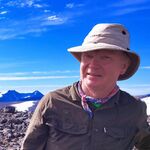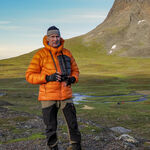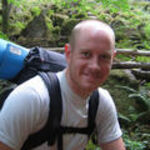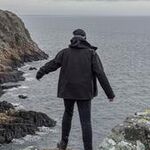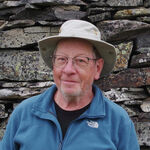A Classic Hike in Sarek: Saltoluokta - Ritsem
Det här är en berättelse om Viktors första Sarekvandring sommaren 2019 med bilder, vägval, filmer med mera. Text på engelska.
Av: adropofnature
This is a description of my first Sarek hike in the summer of 2019 including photos, route choices and more.
This story starts on an SAS flight from Oslo to Tromso in 2013. I pick up the in-flight magazine and start reading an article about the Kungsleden. I did not know then that this would lead me to the heart of Sarek 6 years later.
Prologue:
Reading the magazine inspired me to try and organize a trip to hike the Kungsleden, which I managed to do with a friend in the summer of 2014. We did a 2 week tour from Abisko to Vakkotavare with a detour to climb Kebnekaise. As this was my first hike, my gear was very heavy and not too good, however, I enjoyed the experience so much that I became very passionate about hiking. Already, sitting on the bus from Vakkotavare to Gallivare I started wondering what my next adventure would be. Looking out the bus window I could see high mountains and wildereness across Suorvajaure. I did not know the name then, but this was Sarek.
In the years following, I tried to build my experience with hikes in Norway (Jotunheimen NP), Finland (Urho Kekkonen NP) and Scotland (Cairngorms NP). After the summer season of 2018 and my hike in Jotunheimen, I finally felt that I was ready for a new challenge, I felt I was ready for Sarek. Thus the long preparation and planning began. I invested in new gear and bought books and maps to help get to know the area. Naturally, this is when I found Utsidan which was extremely helpful, and so I would like to thank everyone who has contributed to this lovely website.
I was at first a bit hesitant in writing this article. I have not seen any writings in English here, but I checked the site rules which says it is allowed. I have enjoyed reading articles on this website for two years now and have learned a lot, so I feel the need to give back to the community. Sadly, I do not speak Swedish, and have been reading articles with the help of google translate. It actually works really well! I hope my post will be of use to some of you.
After all the planning, I arrived at a plan to hike from Saltoluokta to Ritsem via Kungsleden -> Rapadalen -> Skarja -> Ruohtesvagge -> Padjalentaleden. Some would call this the Sarek Classic... I convinced my sister and her partner to join me and my partner on the hike, so it would be the four of us embarking on this adventure. I do not enjoy hurrying in the mountains, I like to take my time and enjoy my surroundings. So for this trip of 120km I planned 12 days which would allow for bad weather and laziness.
The logistics were the hardest part to get right. We would arrive by plane, but then what? Since it was four of us I calculated that due to high cost of public transport in Sweden, we would be better off hiring a car even though it would just be parked for 12 days. This also gave the extra convenience that we could leave things in the car and so we did not have to travel in hiking clothes.
Everything is packed and ready to go.
It's finally time to travel. The flight and car rental went well and we arrive at Kebnats 30min before the boat leaves, so we get everything ready, change into our hiking boots and head off to the pier to board the M/S Langas which promptly departs at 4pm. At Saltoluokta we indulge in the last bits of luxury before our 2 week expedition, for some this is a pint of beer, for others this is a cup of tea and some cake. A quick measurement on the hanging scale reveals that the girls carry 16kg while the guys carry 22kg, not bad for two weeks by my judgment.
Final pieces of luxury at Saltoluokta.
Day 1:
Around 5pm we start our hike on the Kungsleden towards Sitojaure. Our goal is to catch the last boat over the lake tomorrow, so we want to get as far as we can today. The weather is cloudy, but the temperature is pleasant and there is no sign of rain. The Kungsleden is very easy to walk and after a little struggle uphill in the birch forest, we find ourselves on the barren plateau. Around 8pm we set up camp with amazing views towards Pietsjaure and Lulep Gierkav. It starts to rain so after dinner we quickly seek shelter in our tents.
The view towards Pietsjaure and Lulep Gierkav from our campsite.
Day 2:
There were some heavy rains overnight, but we all slept well. There is something very southing in the sound of rain hitting the canvas, I sleep much better in rain and wind than when it is calm and quiet. The weather looks great, the sun is shining and so we try to dry the tents while we pack our bags. We postpone the breakfast till we reach the shelter at Avtsusjvagge. As expected from the Kungsleden, we see quite a few people this day. During breakfast, a nice Swedish man joins us in the hut and offers us smoked reindeer which tastes really good. I decide to try to buy some at the Sami settlement at Sitojaure, but when we get there they inform me that it is out of stock. No problem, we console ourselves with a can of beer which they do have. We are transported to the other side of the lake around 5pm. Here, we continue till the last stream marked on the map, where we collect a lot of water, based on the map there will not be any more available till we reach Skierffe the next day. This assumption turns out to be correct. Just as we come to the treeline, there is an open flat area with amazing views towards Sitojaure, a perfect campsite. We go to bed hoping for good weather so that we can enjoy the views from Skieffe the next day.
Sitojaure in the morning from just below Martevarasj. Our campsite was close above the treeline in the middle of the photo.
Day 3:
The night was very calm and the morning is everything we hoped for, sunshine and no clouds. We wake up early and leave as this promises to be a long day. We again postpone breakfast which will be a reward when completing the climb up to the plateau around Doaresoajvve. The path becomes rocky towards the end of the ascent, but nothing to worry about, at the top we enjoy our reward, granola with powdered milk.
The rocky slope and Sitojaure from near the top of the climb, with Martevarasj on the right.
After lunch it was time to part way with the Kungsleden. The terrain here on the plateau is really easy to walk. We round Doaresoajvve from the south and join the path up to Skierffe just after we enter Sarek. There is a little stream on the path near Sliengetjahkka (1110m) where we freshen up and fill up our bottles, this is the first source of water since Sitojaure. The weather is still great, with the sun heating up the air it feels pleasantly hot. I hike in only a shirt. At the foot of Skierffe, we abandon our rucksacks and head towards the peak. Without our bags it takes no time to reach the top, where the view opens up towards the Rapa Delta. The view up here is amazing, probably the best I've ever seen. Looking towards the west, we can see what awaits us in the coming days.
The Rapa delta from the top of Skierffe.
Rapadalen and Nammasj from Skierffe.
We spent around an hour up there, but eventually made the descent and collected our bags. We then continue north-west down to the area at Tjasskavarasj where we plan to camp. The terrain is easy at the start, but becomes harder due to the thick bushes that come to our knees. We make it through and find a spot to camp with great views of the Rapa valley and Nammasj.
Having dinner with our tents at Tjasskavarasj.
Day 4:
Yesterday was a tough day, so we need some time to recover. We awaken to the sound of rain so decide to have a lazy morning and and snooze in our cozy sleeping bags. Looking out from the tent I see moving low clouds in Rapadalen which flow towards Nammasj where they whip up into a spiral. It is a great sight and so I decide to leave the warmth of the sleeping bag and take a timelapse.
The Clouds over Rapadalen in the morning.
The weather does not really improve, so around noon we decided to pack up and get going. We take aim to round Gierdogiesjtjahkka (1343m) from the south and then cross the saddle between Niehter (1579m) and Suorkitjahkka (1220m). As we start climbing towards the small "plateau" that is seen on the map on the southern slope of Gierdogiesjtjahkka, the terrain becomes increasingly littered with large boulders, which are very slippery from the rain. We advance very slowly, but at least we have the view of Skierffe and Rapadalen to admire.
I am struggling on the slippery rocks above Rapadalen.
The terrain becomes a lot better to walk as we approach the river flowing down from Niehter, even the sun reminds us that it is still in existence. As we approach the saddle, the terrain becomes worse again, but there is a large snowfield that covers the valley all the way to the top. Thus we choose to take the "easy" route and walk to the top of the saddle on the snowfield, it is a nice break from the boulders.
On the snowfield between Niehter and Suorkitjahkka near the saddle.
The gently sloping area around Buovdajagasj is a maze of grassy patches and block terrain. We try to navigate around the boulder fields, but we always somehow find ourselves surrounded by nothing but rocks. We advance very slowly until we reach Buovdajagasj hiding in a ravine. We arrive at the river just on the edge of a snowfield that hangs over it. I am unsure whether to attempt to cross on the snow. It seems thick enough, but then again, it is a long fall down to river flowing below. We judge that is safe to cross and as a precaution, we tie ourselves together for the crossing with a rope, better safe than sorry. The crossing goes without problems although we do have to jump over a small crevasse that has opened up in the middle. On the other side, the block terrain continues. It's getting late and so we must find somewhere to pitch the tents, but all we can see are rock. Then suddenly, out of nowhere, a small patch of grass appears with space for precisely two tents. We set up camp just as the sun sets, the temperature quickly plummets here on the exposed plateau. We cook dinner inside the tent before turning in for the night.
Day 5:
We wake up to promising weather, although some rain clouds seem to be hanging around. Luckily there will be very little rain this day, and actually this is the last bit of rain we see in the daytime for the next week! Yes, we were so lucky to have 7 days without a drop of rain in Sarek. Today is my sister's birthday. So we take it slow and have a lazy morning, to her request we plan to have a short day of walking, we only plan to get to the slopes of Vassjalabdda. We set off around 1pm and head south of peak 1278m. The terrain here is quite strange. It is completely covered by rock, but unlike yesterday, the rocks are nearly completely flat on top so it is very easy to walk.
Flat rocks just west of peak 1278m. The balloons mark the birthday girl.
The more we walk, the more the view towards Rapaselet starts to open up, it looks amazing. We will be heading down there tomorrow, but from up here it looks easy to walk, tomorrow I will find out how wrong this assumption was. As we approach Lulep Vassjajagasj we can hear it before we can see it. It has dug itself into a deep ravine and it is quite hard to find somewhere to descend to its shore. The crossing goes fine, this is the first time we have to change into our waders. About 1km from the crossing, we find a nice spot for the tents with a lovely view of Rapaselet, so we call it a day.
Our campsite with a view of Rapaselet.
Day 6:
As usual, I sleep very well. We wake up to sunshine, although there is some interesting mist down in the valley which sometimes forms into small patches of clouds that hit the sides of the valley and then dissipate. It seems like a good opportunity to take another timelapse.
The clouds forming in Rapaselet.
The plan for the day is to head down to the Rapa valley and make it all the way to the start of the climb up to Snavvavagge. I am unsure where to descend to the valley though. We start by trying to keep height to avoid the dense vegetation, but soon we find ourselves in bushes that are very hard to walk in. The hillside get steeper and steeper, so we decide to go directly down while hanging onto the branches to avoid slipping. After some struggle we make it to the birch forest, where we start walking towards Alep Vassjajagasj. It is a struggle. The forest floor is very dense and littered with holes and wetlands. We eventually get to the river where we discover a well trodden path that runs on the southern shore. Probably if we would have kept a lot more height from the campsite, we could have joined this path higher up the hillside.
Rapaselet from the path on the south side of Alep Vassjajagasj.
When we get close to the Rapa river, we find a nice spot to have a break and take a bath in the river. The sun has been shining all day and the temperature is nice and warm. After lunch, we easily cross the river in our waders. I've read in many posts here on Utsidan that if the water levels are low, one can follow the shore of Rahpaadno all the way to Snavvavagge. So after crossing the river we try to reach the walk all the way to the shore, but our path is closed off by large bodies of water and swamps. We try for half an hour to try to find some way down to the river, but we have no success. We abandon the plans and continue on the path through the forest. I am to this day quite disappointed that we did not manage to find the river path, but we could not waste much more time. The hike through the forest was tough, at times we would loose the path for a while and just plow on through the dense vegetation. We had to cross some deep swamps as well, where our boots got full of unappetising swamp juice.
Rapaselet near Skarkistugan.
We eventually make it to the ascent towards Snavvavagge, but it is getting late and the sun is setting so we must hurry. Just above the treeline we find our preplanned campsite which has amazing views towards Sarvesvagge.
Finally arrived just in time for sunset. Great views of the meeting of Sarvesvagge and Rapadalen.
Our tent at night with the dark silhouette of Laddebakte.
Day 7:
We woke up to the heat of sunshine again, it was a very calm night, not even any wind. We start early as it will be a day with a lot of up-and-down. The plan is to get up and over Snavvavagge and try to get as far towards Skarja as possible. The climbs are quite tough, especially to start the morning with, my muscles are still aching from the heavy use yesterday. The view back over Rapaselet is magnificent with the distinctive cone shaped Sutor Skoarkki towering over it.
Nearly up, the last bit of the climb. The peak in the background is Sutor Skoarkki.
Snavvavagge is quite barren, the path disappears here but the terrain is really easy to walk so we cross the valley in no time. At the far side we take a break and have lunch where the lakes drain into Alep Snavvajagasj.
The barren Snavvavagge seen from the saddle at 1066m.
I have read about the tough descent around Spokstenen, so I was not looking forward to this. At least the weather was great so we did not have to worry about slippery rocks. As we exit Snavvavagge to the north, a whole new view opens up towards the northern Rapadalen. We sit down for a while to observe.
The upper Rapadalen and Skarja seen from Snavvavagge. The path passes just below the cliff on the right.
The view south towards Sarvesvagge.
The descent from Sarvesvagge is as advertised, very rocky and tough. Sometimes one has to use hands to aide in the large steps down rocks, but it is definitely doable in dry weather. It would be very tough in rain, especially on the way down. Once we arrived under the cliff shown in the above photo, the path climbs a bit onto the plateau around Bielavarasj. The landscape opens up a lot here, there is a large area between the mountains. The terrain is very flat and grassy here, so the going is very easy. We have to change shoes to ford Bielajahka, but it is easily done. The view east towards the Ahpar massif is magnificent.
Bielajahka with the sunny Ahpar massif in the background.
We shortly arrive at Tjaggnarisjahka, which already based on just the sound will be a hard one to cross. It is already getting late and we are very tired, so we decide to set up camp on this side of the river. We hope that there will be less water in the river after a cold night. The sunset over the Ruohtes massif gives a great ambiance to our dinner.
The sunset over Ruohtes from the shores of Tjaggnarisjahka. The distinctive peak in the distance must be Guohper.
Day 8:
The clouds have returned and threaten some rain, but as the morning progresses it improves. There is indeed a bit less water in the river this morning, but the crossing is still really difficult, probably the most difficult of the hike. We find a decent place to cross a bit downstream from the path and we all make it to the other side dry. The route to Skarja is very easy and we make it there in quckly. We have an early lunch in the hut. It feels quite strange to sit down at a table inside. After lunch we play some cards and have some tea. As expected we meet many people in such a central location although I would not call it a crowd. Overall we have seen a lot less people till now than I expected. All the way from Skierffe to here we saw 3 people, but two of them only from a distance.
The dark Sarek massif and Mihkajiegna from the sunny Skarja.
After a long rest, we continue our hike into Ruohtesvagge, our home for the next two days. The ground here is very grassy and easy to walk on. As we arrive under Gavabakte and the small glaciers that hang under it, we decide to pith up the tents next to Smajlajjahka. The river that is fed by these glaciers splits into many arms as it flows down into Ruohtesvagge. As it washes the vegetation away, the bare rock it leaves behind provides a nice contrast to the green valley.
Glacial river on the north side of Ruohtesvagge.
Just as we set up camp, the wind starts picking up and some black clouds are looming in the distance. This is complemented by some low lying clouds, which in turn provide the canvas for a spectacular sunset.
Sunset over Ruohtesvagge.
Day 9:
The aforementioned dark clouds resulted in heavy rain overnight, but the tents took it well. As I wake up and look outside, there are dozens of small streams that have formed around our tents, but luckily none directly under. The weather is still very cloudy, but there's no rain. After breakfast, we continue north. After an hour we reach the point we have to cross Smajlajjahka. The river is very murky from the glacial sediment carried down from Ruohtesjiegna, so it is hard to judge its depth. In this area, the river spreads out into many arms, so the flow is quite slow and gentle. The crossing turns out to be one of the easier ones due to the sandy bottom and slow flow, although I can imagine that earlier in the year this could be a real challenge. On the other side, we climb up the small hill Ruohtesvarasj (1010m) to get a better view of Ruohtesjiegna. Just as we settle here for lunch, the clouds begin to part and we start to see some glimpses of sunshine. I take the opportunity for another timelapse.
The clouds parting over Ruohtesjiegna.
While enjoying our lunch, the glacier makes a huge sound that echoes through the valley. It is a nice reminder of the power of nature. We continue north until we reach the foot of Nijak, where we pitch up for the night. As the sun sets, a bit of cloud sits over the top of Nijak like it is wearing a hat.
Nijak illuminated by the setting sun.
Day 10:
I wake up in the morning to huge gusts of wind as it rattles the tent. It is very strange, every minute or so there is a 10 second period of giant wind, and then 50 seconds of complete calmness. By the time we decide to get up, it stops and the sun shines. We decide not to take the shortcut towards Sjnjuvtjudisjavarasjjahka (I would love to know how to pronounce this ...) and head towards the meeting point of the three national parks. We have a nice view of the Ahkka massif all day, but other than this it is quite uneventful. The going is easy. Perhaps the biggest event is that we see our first tree for many days, we are approaching the end. Just before the three park point, we stop for the night. Here we are wedged between two big rivers, Sjpietjavjahka and Sjnjuvtjudisjahka.
Day 11:
This is our final day. The padjalentaleden feels like a highway after so long in Sarek. We take it easy and eat a lot of blueberries on the way. The Ahkka massif is still magnificent as it overpowers the view. I am amazed by the amount of water in Vuojatadno and am very happy for the bridge. This river would be absolutely impossible to cross in any weather. Late afternoon we arrive at the pier in Anonjalmme. The boats did not run today due to the strong wind, but we are hopeful of tomorrow. We find somewhere to camp nearby and prepare to wake up early for breakfast in Cafe Eno, what a lovely place.
Vuojatadno with Ahkka to the left.
The next day, we have breakfast as planned and take the boat to Ritsem. We then board the bus to Kebnats where we are reunited with our car.
Epilogue:
Sarek has definitely left a mark on me, and it is quite hard to explain why. Many aspects that I enjoy about it are recreated somewhere else where I have visited. The wide open valleys of Kebnekaise, the remoteness of Urho Kekkonen National Park and the dramatic peaks of Jotunheimen. However, Sarek seems to combine all of the above which give it a distinctive charm. What I can say for certain is that this was not my last visit to the National Park. I expect not to be so lucky with the weather next time, but oh well, you win some you lose some. This trip was most definitely a win!
Läs mer
Forumdiskussioner
- Fjällvandring Resa till Abisko
- Fjällvandring Gissa position
- Fjällvandring Kungsleden på 7-8 dagar.
- Fjällvandring Hur uppbokade blir nattågen?
- Fjällvandring Vad hittade vi vid leden?
- Fjällvandring Sveriges vackraste glaciär?
- Vandringsleder Bilder från din senaste tur (ej i fjällen)
- Fjällvandring Min farmors systers Sarek-vandring någon gång under 40- eller 50-talet

































